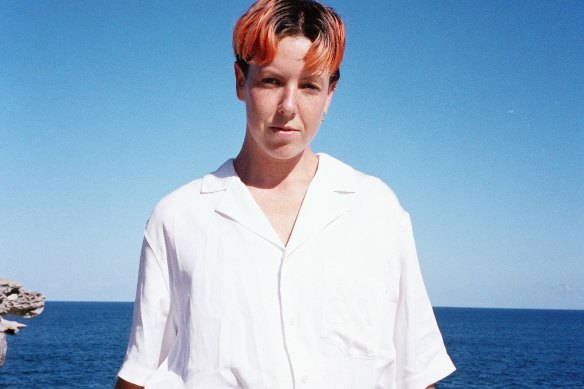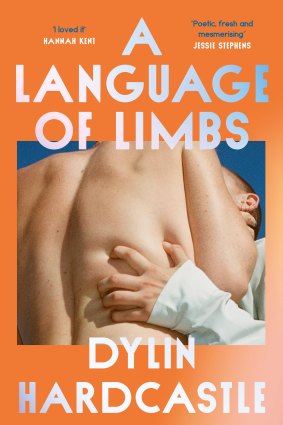By Declan Fry
FICTION
A Language of Limbs
Dylin Hardcastle
Picador, $34.99
“All my life I’ve felt I was in two places at the same time,” reflects Irène Jacob in Krzysztof Kieślowski’s 1991 film, The Double Life of Veronique. Kieślowski’s sinewy meditation on loneliness, doubling and defamiliarisation has a strange charm. Like a love letter addressed to an anonymous recipient, it depicts the bond – a bond transcending time, geography, identity, even language – between two women who have never met.

Dylin Hardcastle’s A Language of Limbs features words and phrases that appear in one character’s story and echo in that of the second main character.Credit: Cloudy Rhodes
Kieślowski’s film would seem, for the queer women at the centre of Dylin Hardcastle’s second novel, thoroughly realist. Each has separate, alternating chapters – “limb one” and “limb two” – and both are nameless, or almost.
“Limb one”, born Lucy, is a writer. Her parents discover her sleeping with another woman; she discovers familial attachments are limited (by some combination of prejudice, disgust and refusal, who can say). The year is 1972, the place is Newcastle.
Fleeing home, a man, Dave, picks her up. Dave inadvertently offers her the outline of a new identity: “it dawns on me that I can be anyone”, Lucy – now “Little Dave” – reflects.

Credit: Supplied
Lucy/Little Dave finds refuge among chosen family at Uranian House. (“Uranian” was a term taken up as a rallying cry by advocates of homosexual emancipation during the Victorian era.) Over the next two decades, she will witness – and be intimately involved in – a sentimental education at Uranian House’s self-managed queer bar and living space. Australia’s first Mardi Gras, the burgeoning queer arts scene and the HIV/AIDS pandemic, all are canvassed.
Limb two, Suzanne, is a star student and editor. Her narrative is an uncanny valley of middle-class achievements and milestones, tricked out with doting parents (her mother is constantly reaching for another bottle of celebratory champagne; the avuncular father is fond of words such as “cracking” and “riveting”). Cottagecore comfort, praise and attention attend Suzanne’s mostly frictionless path towards independence.
Yet that “mostly” counts for something: at an age when longing may take the rest of life hostage, a high-school classmate captures her heart. Suzanne’s paramour refuses to be consigned to the past; she suppresses the desire, embarking on a more readily acceptable path with Thomas, her Welsh husband.
What remains perhaps unlived – even unsought – nonetheless retains the power to determine what each woman will become. Words, phrases, and expressions occur in one limb before being reprised, déjà vu-fresh, in the story of the other. Implicit in this doubling is the idea that behind each self there might be a third or fourth iteration – another way of being in the world, or of living in a world that is more accommodating of their lives.
Five years after Hardcastle’s novel is set – and 17,000 kilometres from Newcastle – Roland Barthes wrote, in A Lover’s Discourse, that over the course of 100 years literary madness has too often been understood as a form of depersonalisation. Rimbaud famously summarised the condition: “I am another.” Where love is concerned, Barthes suggested, coherence itself becomes a problem: “For me as an amorous subject [...] it is becoming a subject, being unable to keep myself from doing so, which drives me mad. I am not someone else: that is what I realise with horror.”
Lucy and Suzanne exist in a time when queer love and selfhood are prey to a kind of societal madness, the material and psychic entrapment of heteronormative refusal. Hardcastle explores this in terms of gender, sexuality and race, sometimes uneasily, as when an Australian with Vietnamese parents – Han – engages in a stagy bout of consciousness-raising with a white woman intent on confusing Vietnam with Thailand (when she isn’t posing the old “No, but where are you really from?” chestnut).
Han’s introduction in the narrative feels like typecasting: after educating Suzanne about the need for diversity in publishing, she more or less disappears, like an unusually obliging sensitivity reader, a white character’s guru.
In A Language of Limbs, the perpetrators of violence include families, street thugs, publishers – even the marginalised themselves. In one scene, Lucy hurts her partner, Caragh, in what reads like an instance of bisexual erasure. Lucy gets pulled up on it; but elsewhere, the novel suggests, in lieu of accountability, perpetrators are only innocents awaiting the proof of a guilt that will never be delivered: their victims are guilty already.
Towards the end of the novel, Lucy reflects on her childhood, before “my body swelled and became something like a shadow, outside and beyond, stalking the edge of me”. A shadow stalks each woman. Sometimes that shadow is their younger self; sometimes it is their unknown counterpart, a person who might have had the chance to live differently because of them.
Time moves unpredictably for each. They look for the names of things they do not yet have names for, the shape of a territory they do not yet know may exist. Even a shadow needs predecessors, outlines, to become visible.
The Booklist is a weekly newsletter for book lovers from books editor Jason Steger. Get it delivered every Friday.